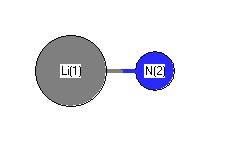Jump to
S2C1
Energy calculated at CCD/6-31+G**
| | hartrees |
|---|
| Energy at 0K | -61.944926 |
| Energy at 298.15K | |
| HF Energy | -61.816713 |
| Nuclear repulsion energy | 5.830328 |
The energy at 298.15K was derived from the energy at 0K
and an integrated heat capacity that used the calculated vibrational frequencies.
Geometric Data calculated at CCD/6-31+G**
Point Group is C∞v
Cartesians (Å)
| Atom |
x (Å) |
y (Å) |
z (Å) |
|---|
| Li1 |
0.000 |
0.000 |
-1.334 |
| N2 |
0.000 |
0.000 |
0.572 |
Atom - Atom Distances (Å)
 More geometry information
More geometry information
Electronic energy levels
Charges, Dipole, Quadrupole and Polarizability
Charges from optimized geometry at CCD/6-31+G**
Charges (e)
| Number |
Element |
Mulliken |
CHELPG |
AIM |
ESP |
| 1 |
3 |
0.000 |
0.000 |
-1.334 |
|
| 2 |
7 |
0.000 |
0.000 |
0.572 |
|
Electric dipole moments
Electric dipole components in Debye
(What's a Debye? See section
VII.A.3)
| |
x |
y |
z |
Total |
| |
0.000 |
0.000 |
-7.512 |
7.512 |
| CHELPG |
|
|
|
|
| AIM |
|
|
|
|
| ESP |
|
|
|
|
Electric Quadrupole moment
Quadrupole components in D Å
Polarizabilities
Components of the polarizability tensor.
Units are
Å
3 (Angstrom cubed)
Change units.
| |
x |
y |
z |
| x |
0.000 |
0.000 |
0.000 |
| y |
0.000 |
0.000 |
0.000 |
| z |
0.000 |
0.000 |
0.000 |
<r2> (average value of r
2) Å
2
| <r2> |
11.819 |
| (<r2>)1/2 |
3.438 |
Jump to
S1C1
Energy calculated at CCD/6-31+G**
| | hartrees |
|---|
| Energy at 0K | -61.879742 |
| Energy at 298.15K | -61.879711 |
| Nuclear repulsion energy | 5.951871 |
The energy at 298.15K was derived from the energy at 0K
and an integrated heat capacity that used the calculated vibrational frequencies.
Geometric Data calculated at CCD/6-31+G**
Point Group is C∞v
Cartesians (Å)
| Atom |
x (Å) |
y (Å) |
z (Å) |
|---|
| Li1 |
0.000 |
0.000 |
-1.307 |
| N2 |
0.000 |
0.000 |
0.560 |
Atom - Atom Distances (Å)
 More geometry information
More geometry information
Electronic energy levels
Charges, Dipole, Quadrupole and Polarizability
